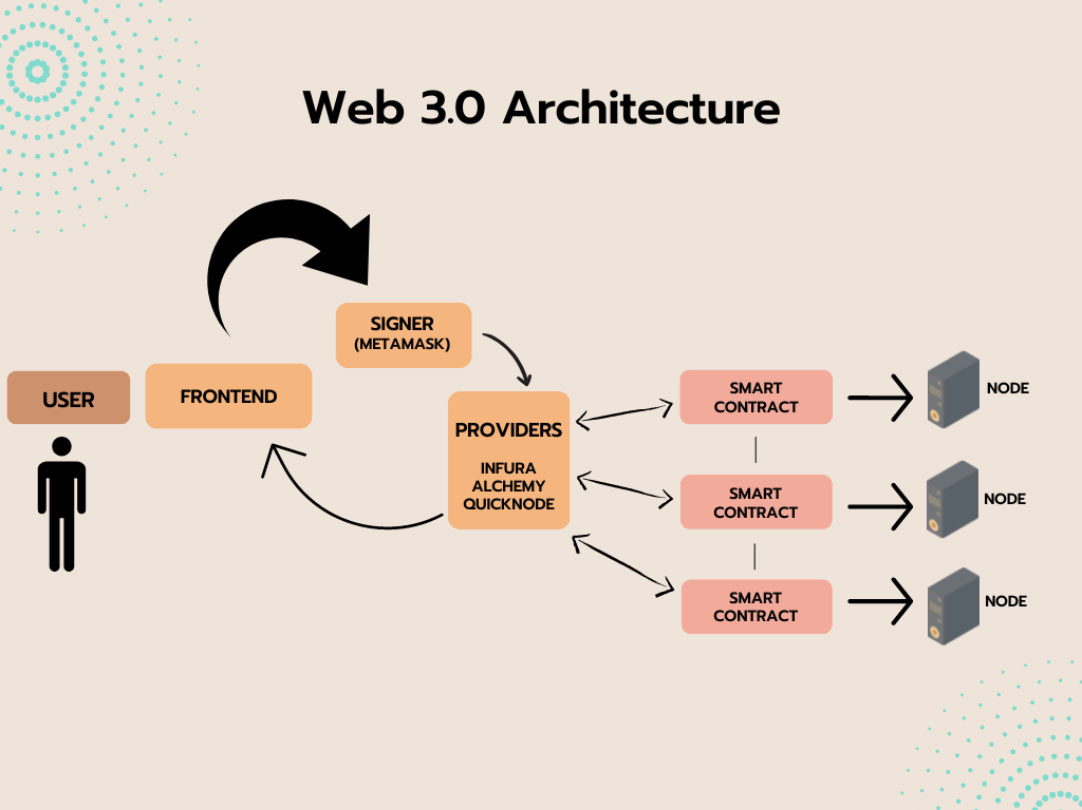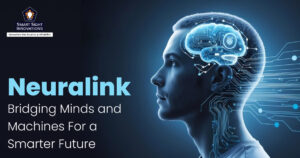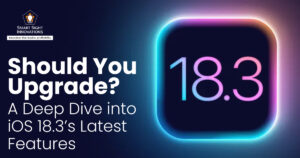 Web 3.0 is a decentralized technology powered by blockchain that gives users an efficient and secure means to store data and ensures user privacy. One of the cornerstones of web 3.0 creation was to overcome the centralization of control, ownership of data, and lack of data privacy on web.2.0 platforms. This has led to a major turning point that we can no longer ignore.
Web 3.0 is a decentralized technology powered by blockchain that gives users an efficient and secure means to store data and ensures user privacy. One of the cornerstones of web 3.0 creation was to overcome the centralization of control, ownership of data, and lack of data privacy on web.2.0 platforms. This has led to a major turning point that we can no longer ignore.
Looking at the gradual progression of the internet gives us an insight into the endeavors that have built the technology to meet the demands of the day.
 `
`
How to Build a Web 3.0 App?
While the process of building a web 3.0 app, also called decentralized apps (or dapps) depends on the type and purpose of the app, certain essential aspects make up vital components of the app.
To give you a parallel, a website that allows you to publish content that others can read (such as a blog) typically consists of:
- A central database that stores essential data (user information, comments, etc.).
- A backend stack that describes the business logic of the website, which takes users to the next logical step in their interaction with the website. For example, what happens when a user likes a specific blog post on the website.
- The third is the front-end or the customer-facing design that describes how the users interact with the website.
But web 3.0 has totally changed how users interact with the web as it completely removes the middle man (in this case, the centralized database). This means there’s no database where the backend or front-end code is stored and instead is run by decentralized nodes on the internet. Some of the vital components to build a web 3.0 app are:
Blockchain
The single biggest difference in web 3.0 is the absence of a centralized server. Dapps utilize the blockchain to distribute the application over a network of computers, where the blockchain acts as a “state machine” that maintains the program state and validates the predefined rules.
You can utilize the blockchain to build dapps on the decentralized network that is maintained by everyone involved in the network. All blockchain applications must have their code on the decentralized network.
The Ethereum blockchain is one such “state machine,” maintained by a peer-to-peer network of nodes, which is to say that anyone in the world can get access to this machine and write to it. This is because no one person or entity owns the machine. But one vital thing to remember about web 3.0 is that data can only be written to the Ethereum blockchain network and can never be updated or edited.
Smart Contracts
Smart contracts in web 3.0 are like the backend server that define the way your applications work and run them on the blockchain state machine.
A smart contract is a program executed on the Ethereum blockchain and defines how the changes occur on the blockchain. Solidity and Viper are some of the languages used to write smart contracts. All smart contracts are stored on the Ethereum blockchain — accessible by anyone — which means the apps themselves can be analyzed by anyone on the network.
Ethereum Virtual Machine
The Ethereum Virtual Machine understands and executes the changes based on the smart contracts, which will be visible to everyone in the globally distributed network.
Frontend
The final piece in the puzzle is the front end, which communicates with the application logic explained by smart contracts. Since Ethereum is a decentralized network, every node on the network contains all the information on the network, including the code and data linked to each smart contract. Any node on the network can execute a new transaction, and initiating communication can happen in two ways:
- Setting up your own node that runs the Ethereum blockchain software (this requires a lot of resources and time, which is not feasible for individuals).
- Use existing nodes set up by third-party service providers like Infura, Alchemy, and Quicknode.
New transactions are typically forwarded by miners to the rest of the network. The new nodes that you connect with to communicate with the blockchain are called “providers.” Providers usually implement a JSON-RPC specification (a lightweight remote procedure call protocol or RPC) to relay information within the blockchain network. An RPC is a request-response mechanism that outlines the rules for clients to communicate with remote machines and execute the said function and receive a response.
These communications, which use JSON as the data format over HTTP, pass and retrieve data as the providers are connected to the blockchain. But to write to the blockchain network, you need what is known as a “client key,” and each transaction (in effect, each request) costs a gas fee. This gas fee is typically cryptocurrency that’s paid to the miners who verify the transaction.
Metamask is one such provider, that stores the private key in the browser and signs when a client makes a transaction request. These providers act as connections in the blockchain network.
Storage
While the blockchain network is decentralized, meaning everyone can access and store information with no risk to data privacy, storing data on it can become very expensive very quickly. This is because, when it comes to Ethereum, users have to pay every time they add new data to the blockchain as adding a new state to the decentralized state machine increases the costs for nodes that maintain that state machine.
This is where using decentralized storage solutions like IPFS or Swarm is useful. The next step is deploying an application like Graph, which is an off-chain solution that helps read data from the smart contracts on the blockchain. Graph allows you to explain which smart contracts to index and how you can convert incoming events into entities for your front-end logic.

Current limitations of Web 3.0
While the decentralization of information in web 3.0 prevents the monetization of private data, the current state of web 3.0 infrastructure does come with some limitations. Some of them are:
- Scalability. Carrying out tasks on web 3.0 could take more time. This is because, in the typical web 2.0 architecture, all participants are connected to a centralized system, which leads to quicker circulation of data as against the web 3.0 architecture, in which certain nodes on the network could be much farther away from each other and cause a delay in relaying the information.
- Inconsistent resolution times. A possible advantage of a centralized authority is that conflicts can be resolved by depending on the single instance of truth. The decentralization in web 3.0 could lead to a situation where peers make conflicting claims about a particular piece of data, which was supposed to be in agreement. Such disputes may need complex protocols for resolution, and one that will need more time and effort.
- Price. Most dapps choose to have minute portions of their code on the blockchain as otherwise, the costs could skyrocket.
- Availability. Most modern web browsers still don’t support web 3.0 applications, which means it’s not as easily accessible.
Building a Web 3.0 App
While building a web 3.0 app depends on the purpose and type of application, there are some essential components:
- Blockchain
- Smart contracts
- Ethereum Virtual Machine
- Frontend
- Storage













